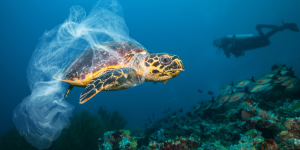Breaking: Australian Coastal Pollution Decreases by Over One-Third, CSIRO Reports Ongoing Cigarette Butt Challenge
Anúncios
Overview of Plastic Pollution Reduction 🌍
Recent research highlights a remarkable 39% decrease in plastic pollution along Australian coastlines over the past decade.
This decline reflects the concerted effort and increased awareness among communities and policymakers regarding the impact of plastic waste on the environment. 🌊

Reduction in Debris Density 📉
The comprehensive study, which surveyed 1,907 locations across six major Australian cities, provides detailed insights into the status of coastal pollution.
The debris density has dropped significantly, from 0.23 items per square meter in 2013 to 0.14 items per square meter in 2023.
This reduction is a clear indicator that mitigation strategies and public consciousness are yielding positive results.
Alarming Drop in Plastic Waste 🛑
One of the most encouraging findings is the 16% increase in areas with no plastic debris at all.
These pristine sites serve as benchmarks and encourage further efforts towards a completely litter-free coastline.
The study meticulously recorded and analyzed a total of 8,383 debris items, revealing critical data on the types and distribution of coastal pollution.
Persistent Plastic Challenges 🚬
The findings underscore persistent challenges, particularly concerning cigarette butts and polystyrene fragments, the most common types of debris identified.
These items were especially prevalent in high-density human activity areas, including residential and commercial locations, demonstrating the strong correlation between human presence and debris density.
Despite the overall decline in plastic pollution, these stubborn pollutants remain a significant concern.
Implications for Future Strategies 🌱
The observed reduction in coastal pollution sets a crucial baseline for evaluating the effectiveness of future environmental policies.
The study’s findings will inform waste management strategies and education campaigns aimed at sustaining and advancing the progress already made.
However, projections indicate that, without ongoing efforts and further action, up to 53 million metric tonnes of plastic waste could enter aquatic ecosystems by 2030. 🌊
Moving forward, it is essential to leverage these findings to develop and implement more efficient pollution control measures.
The continuous efforts to address the various factors influencing coastal pollution will be crucial in achieving long-term sustainability and environmental health.
Study Methodology and Scope 🔍
Survey Coverage 🗺️
The recent study conducted by the Commonwealth Scientific and Industrial Research Organisation (CSIRO) meticulously surveyed 1,907 locations across six major Australian cities.
The cities included in the study were Hobart, Newcastle, Perth, Port Augusta, Sunshine Coast, and Alice Springs.
The researchers extended the survey to cover inland, riverine, and coastal habitats situated within a 100km radius around each city, offering a comprehensive view of how land use impacts debris dispersion.
Data Collection 📊
To ensure a robust dataset, the project focused on recording and analyzing a total of 8,383 debris items.
Each item was documented with meticulous detail concerning its type, location, and the context within which it was found.
This method allowed the researchers to generate an in-depth understanding of the geographic and environmental factors influencing debris accumulation.
Survey Focus and Duration ⏳
The surveys were conducted over a span of two years, from 2022 to 2024.
This timeline allowed the researchers to observe seasonal variations and account for any short-term changes due to external factors.
The extended duration of the study provides confidence in the reliability and consistency of the findings. 📅
Identification of Debris Hotspots 🔥
One of the significant aspects of the study was identifying debris hotspots.
Areas of intensive land use and socio-economically disadvantaged regions exhibited higher levels of debris.
By highlighting these hotspots, the study offers valuable insights into where targeted interventions could be most effective. 🎯
Dr. Steph Brodie, a CSIRO research scientist, emphasized the importance of understanding how different land uses influence debris in the environment.
“We found that areas with intensive land use and socio-economically disadvantaged areas tended to have higher levels of debris,” Dr. Brodie explained.
Persistent Challenges: Cigarette Butts and High-Traffic Areas 🚬
Dominance of Cigarette Butts as Coastal Debris 🚭
Despite the significant reduction in overall plastic pollution along Australian coastlines over the past decade, cigarette butts continue to be a persistent issue.
They remain the most common type of debris found in multiple cities, including Newcastle, Perth, and Sunshine Coast.
The prevalence of cigarette butts is a crucial concern as they contain harmful chemicals and microplastics which endanger wildlife and marine ecosystems.
High Concentrations in Residential and Commercial Areas 🏙️
The study highlights that residential, commercial, and roadway areas exhibit the highest densities of debris, with a strong correlation to human activity levels.
These high-traffic zones are hotspots for pollution due to the sheer volume of people and activities concentrated in these areas.
The density of debris in these regions underscores the importance of focused actions and heightened public consciousness and education to mitigate pollution hotspots.
Correlation with Human Activity 👥
The data shows a clear correlation between debris density and the level of human activity.
The more people use an area, the higher the debris density found.
This correlation indicates that human behavior and activities significantly contribute to the pollution problem.
Effective waste management strategies and public education on the impact of littering are essential to address this issue effectively. ♻️
Conclusion ✅
Overall, while there has been commendable progress in reducing plastic pollution, cigarette butts and high-traffic areas present ongoing challenges.
These findings point to the importance of continued efforts in education, policy-making, and community engagement to further decrease coastal pollution.
Moving forward, understanding the socioeconomic and land use impacts on pollution levels can help design better waste management strategies. 📈
Socioeconomic Factors and Land Use Impact 💰
Influence of Socioeconomic Status on Pollution Levels 🏠
The study has unearthed a critical link between socioeconomic status and debris levels.
It appears that socioeconomically disadvantaged areas face a higher burden of pollution.
These regions tend to have increased debris density, indicating that more affluent areas might have better waste management practices or resources. 🏙️
High Densities in Residential and Commercial Zones 🏘️
The research has shown that residential and commercial areas, alongside roadways, had the highest debris concentrations.
This makes sense, as these areas see significant human traffic and activity, leading to more waste generation.
The bulk of the debris in these zones comprised cigarette butts and food packaging, which were persistently prevalent. 🍔
Minimal Pollution in Agricultural and Natural Parklands 🌾
Contrastingly, agricultural, industrial, and natural parklands had the lowest levels of debris.
These areas, generally characterized by lower human traffic and extensive land use, seem to manage pollution far better.
This could be due to more stringent waste management practices or simply the lower intensity of human activity. 🌳
Implications for Waste Management Strategies 💡
Understanding these patterns is vital for developing targeted waste management strategies.
By focusing on areas with higher debris densities and improving waste handling in socioeconomically disadvantaged regions, policies can become more effective.
The results underscore the need to address waste management comprehensively, focusing particularly on high-traffic zones and areas with fewer resources.
Moreover, this foundational knowledge sets the stage for evaluating and tweaking current waste policies, showcasing the importance of ongoing efforts to reduce pollution levels and prevent further environmental degradation. 🌍
Future Implications and Policy Benchmarks 🏁
As Australia makes substantial headway in reducing coastal pollution, these developments offer a crucial benchmark for evaluating future environmental policies.
With a marked 39% reduction in plastic pollution over the past decade, it’s vital we capitalize on these gains to shape more effective waste management strategies and public education campaigns. 📚
Setting New Benchmarks 🎯
The recent research by CSIRO, published in the Marine Pollution Bulletin, provides an evident framework for assessing how policies impact environmental health.
The study not only records a reduction in plastic debris density from 0.23 items per square meter in 2013 to 0.14 items in 2023, but it also presents an invaluable baseline for tracking the success of ongoing and future interventions. 📊
Informing Waste Management Strategies ♻️
The findings underscore the need for more robust waste management practices.
The data highlights certain hotspots, particularly urban and socioeconomically disadvantaged areas, that require targeted interventions.
By understanding the correlation between high human activity levels and debris density, we can streamline efforts where they are most needed.
Cementing the Role of Education Campaigns 📢
Public education campaigns are another critical component in driving long-term change.
Understanding the harmful impacts of plastic waste on our ecosystems has already played a significant role in the progress observed.
The upsurge in regions with zero plastic debris, now at 16%, proves that informed communities can markedly reduce pollution. 🧑🤝🧑
Projections and Precautionary Measures 🔮
However, the fight against plastic pollution is far from over.
With projections indicating a potential rise of 53 million metric tonnes of plastic waste in aquatic ecosystems by 2030, proactive measures are essential.
Without extraordinary global efforts, we risk undoing the progress made thus far.
It is pertinent for policies to adapt and evolve based on the study’s insights to forestall future environmental degradation. 🌍
Policy Recommendations 📝
| Recommendation | Description |
|---|---|
| Enhanced Regulation and Enforcement 🛑 | Stricter regulations around plastic manufacturing and waste disposal can stem the source of pollution. |
| Community Involvement 🌟 | Programs that encourage local community participation in clean-up drives and educational initiatives can amplify impact. |
| Innovation in Waste Management ⚙️ | Investments in technology to recycle and repurpose plastic waste efficiently can reduce the overall burden on ecosystems. |
| Research and Development 🔬 | Continuous monitoring and research will help in designing adaptive measures responsive to new data and emerging trends. |
The current findings set the stage for policymakers to draft informed and impactful legislation.
Tailoring strategies to address specific challenges such as the persistence of cigarette butts and the high debris density in urban areas will require a concerted effort from all stakeholders.
As we look ahead, it’s clear that the groundwork laid by this study is pivotal for a cleaner, plastic-free coastline. 🌊
As we continue to explore the facets of coastal pollution, the next step is delving into actionable measures and collaboration efforts essential for sustainable waste management. 🌱







